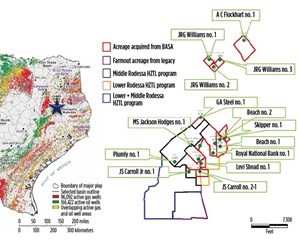Inside the data-driven completions of the future
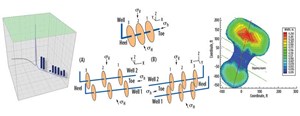
Collapsing oil prices amid the demand-sapping Covid-19 pandemic has aggravated exponentially the economic pressures facing E&P companies, particularly those in the unconventional community. In this wholly unprecedented climate, it is all the more incumbent upon operators to deepen insight into reservoir performance, to enhance production flow within the confines of ever-restricted budgets.
Any exercise directed at maximizing production and estimated ultimate recoveries (EUR) must focus, more than ever, on the frac stimulation and completion programs, which together account for up to 70% of total well costs. For multi-stage shale wells especially, access to affordable stage-by-stage flow profiles to identify non-productive stages and avoid inter-well communication is an indispensable tool, in efforts to maximize production flow across the lateral and minimize costs. However, save for a scant number of engineered “science” wells, these critical data have been unavailable to more than 99% of completed land wells.
Narrowing the wide economic gap between transitioning engineered science wells to the mainstream drove the development of a uniquely engineered portfolio of smart tracers, designed to provide the stage-level flow data once reserved for a select few wells. The field-proven macro particle-based tracers consistently deliver accurate and near real-time detection, well beyond the capabilities of conventional chemical tracers and DNA sequencing technologies, and at comparable costs that essentially equate to a rounding error in the total cost of contemporary completions.
Uniquely abetted with the latest advances in artificial intelligence (AI) and machine learning (ML), the robust, non-radioactive and non-hazardous tracers are engineered with subatomic spectroscopy measurement techniques to map the distribution of well production, the performance of each stage, cross-well interference and environmental containment.¹
Easily deployed, the distinctly tagged and non-intrusive smart tracers maintain stability at excessive temperatures and, compared to standard, chemically-based soluble tracers, remain intact within the fracture network, thereby enabling continuous on-site monitoring of the flow profile over an extended period of time.
Strategically oriented for multi-stage shale wells, the technology suite has also proved effective in applications as diverse as cuttings re-injection (CRI) and saltwater disposal wells (SWD), and enhanced oil recovery and improved oil recovery (EOR/IOR) projects. As reflected in Petralis Energy Resources’ multi-well Tennessee Colony program in East Texas (Fig. 1), the data derived from the smart tracers are equally effective in cutting costs, refining the stimulation and diversion designs, and optimizing full-field development in fractured vertical wells.
Moreover, flow profile data analysis disclosed that in a typical Eagle Ford shale well completed during fourth-quarter 2019, an average 20% of the completed stages are not producing. Consequently, readily identifying non-productive stages and responding accordingly dovetails with an opportunity to remove 20,665 Kg of noxious carbon dioxide (CO2) emissions/well, broken out by the associated reductions in locally sourced frac sand logistic requirements (20,416 kg/well reduction) and pressure pumping hours (249Kg/well reduction). Reducing emissions and environmental footprint is a key metric in operators’ staunchly embraced environmental, social and governance (ESG) initiatives.
Other applications of the smart tracer technology pose similar opportunities to advance ESG initiatives. Identifying precisely where the waste is going in a CRI well is an obvious example, as is the deep injection of a typical saltwater disposal well. In this case, when pumping near a fault, the smart tracer diagnostics can readily help avoid seismic disturbances (earthquakes).
To put in perspective the comparative value of the smart tracers and intelligence diagnostics suite in advancing toward the completions of the future, an examination of current technology offerings is in order.
THE CONVENTIONAL LANDSCAPE
Conventional tracers, based on water- or oil-soluble chemical substances, have been used as reservoir surveillance tools for decades. Labeled tracers with fluorescent properties and ionic, organic materials, or radioactive diagnostic isotopes are used to evaluate fracturing performance, ostensibly to control the effectiveness of multi-stage frac treatments. Owing to obvious environmental deficiencies, tracers incorporating radioactive isotopes have largely fallen out of favor.
Given their soluble characteristics, conventional chemical tracers must be tailored for individual fluid types, thereby requiring more, and often exotic, formulations for a single stage, increasing the chemical tracer costs appreciably. Given the inherent heterogeneity of shale rock along a typical horizontal lateral and the assorted fluid streams, the different types of chemical tracers required could add up to $150,000 in incremental costs/well.
Furthermore, once liquid-based tracers have been pumped, they disseminate quickly and flush from the proppant pack, shortening the effective monitoring period significantly. Thus, between occasionally inconclusive accuracy, cross-well contamination, and downhole temperature restrictions, the use of contemporary chemical tracers is being limited.
Conventional tracer testing, likewise, is severely restricted by the time required to obtain a comprehensive interpretation of the test results. This is normally accomplished from an offsite lab with a minimum three-week turnaround on average, given the longer sample preparation time, expensive instrumentation and specialized reagents needed for analysis.
Perhaps one of the more glaring drawbacks with conventional tracers is the limitation to only chemical measurement techniques at a molecular level, and the frequent instigation of unnecessary signals to what is erroneously perceived as “frac hits.” Consider, for example, a multi-zone well being stimulated with a zipper frac, where most of the pay zones are hydraulically fractured sequentially. A typical, stacked pay shale well would have the predominate fracture with sand proppant, along with a discrete fracture network with very small aperture, open fissures. Chemical tracers tend to percolate deeper into these often-microscopic fissures, usually resulting in the multiple “false positives,” wrongly signaling the completion engineers that all the fractures are communicating and drawing down production.
However, owing to residual prop frac conductivity, once pumping has ceased, the sand-packed fracture is the only one actually contributing to production, while the natural fractures immediately seal, meaning little inter-well communication had been occurring.
Obtaining post-frac flow profiles, especially critical in optimizing multi-stage frac programs, has up to now been mostly unavailable, and usually a cumbersome and enormously costly proposition. Along with requiring specialized and downhole modifications, most standard diagnostic methodologies also generate inferred, rather than direct, measurements of the flow profile.
Production logging tools, for instance, require a wireline intervention, while providing only a medium level of detection accuracy for multi-phase flow and a short snapshot for production profiling. Microseismic, for another, generates shear failure data that can measure fracture geometry, but are unable to provide direct answers for the production profile.
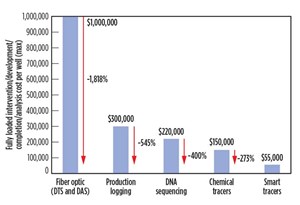
Conversely, fiber optic-enabled, distributed temperature surveys (DTS) and distributed acoustic sensing (DAS) deliver a high degree of detection accuracy and long-term production profiling. However, DAS and DTS systems, which must be installed as part of the completion and necessitate extensive modifications downhole with specialized oriented perforations, come at a high cost, well beyond the resources of most operators, especially within today’s economic regime. Depending on the complexity, the installation of fiber optic DAS and DTS systems can add between $250,000 to $1 million/well to the completed total costs.
The limitations and often prohibitive costs of conventional tracer and current diagnostic technologies encouraged the development of the integrated smart tracer portfolio and digitally enabled intelligent completion diagnostics. The intention was to go beyond providing the client data points, but rather leverage extensive expertise in frac diagnostics to develop new-generation technologies with a costing model that would fit within the economic capabilities of all operators, Fig. 2. Providing critical stage-by-stage production profile data at an affordable price point, which until now had been inaccessible for around 99% of shale wells, would go a long way in closing the loop in the transition to completion designs of the future.
Smart tracer development, application
The engineering of the particle-based, or intelligent, tracer portfolio represents the latest breakthrough in efforts to bring cost-effective nanotechnology to the completions space.2,3 In conjunction with a strategic nanotechnology partner, QuantumPro based its patent-pending smart tracer portfolio on proprietary particles of 1 µm developed from low-cost and environmentally friendly materials. To further assure a low-cost structure, the primary criterion at the onset was to develop a single tracer that would be equally compatible with both oil and water, thereby requiring only one tracer type for each stage, effectively cutting the cost in half compared to conventional chemical tracers.
Notably, the smart tracers are easily deployed—with a precise automated dosage system—and require no additional surface equipment or downhole modifications to the completion.
In facilitating the drive toward wholesale optimization of full-field development, the intelligent tracers were formulated for sub-atomic detection accuracy, with exceptional and field-documented surface recovery rates. Based on diagnostic field data, the technology exhibits exceptional precision in mapping field-wide inter-well communications, or infill frac hits.
To provide both quantitative and qualitative interpretation, all of the smart tracers are subjected to meticulous lab and validation testing, to ensure the designed performance is replicated in the complex fracturing network in the reservoir. During the comprehensive testing protocol, each smart tracer is evaluated for specific characteristics, including high thermal (up to 2,000oF) and pressure stability, settling time, particle size distribution (PSD), as well as reservoir static and dynamic adsorption. The next phase involves aligning and refining each smart tracer with the pre-planned multi-stage frac stimulation design and the estimated completion flow profile. This step validates performance under real-world conditions, including recovery efficiency under minimum and maximum flow velocities at the stage level.
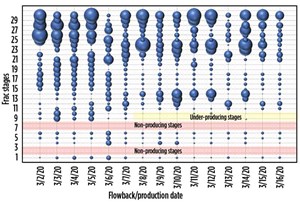
Formulated for specific well characteristics, the smart tracers are pumped unobtrusively with the fluid stream. Unlike their chemical counterparts, once the smart tracers are within the fracture network, the particles are incapable of penetrating into the small fissures opened up, thus mitigating false positive signals for accurate frac hits characterization.
Also antithetical to chemical tracers and a predominate differentiator, once the smart tracers are deployed, they tend to stay in prop frac—rather than quickly dissolve—within the fracture network. Consequently, owing to the heightened stability of the smart tracers, the recovery time is extended considerably, which, in turn, translates into continuous measurement and monitoring of the production profile for up to six months after the original deployment.
The protracted tracer data vs. time profiles is clearly illustrated in Fig. 3, which shows the once largely inaccessible stage-by-stage flow profile of a representative multi-stage well in the Eagle Ford. In this example, 30 stages were monitored daily over a 21-day period, with the size of the bubble reflecting the production volume/day of each stage. Additionally, the data are clear that in the common geometric completions, with equal spacing between the stages and clusters, several stages, likewise, are non-productive in the well.
ON-SITE, REAL-TIME MEASUREMENTS
Unique to the smart tracer portfolio, the results are obtained in near-real time, as opposed to awaiting samples delivery and the completion of off-location lab tests. Once the particles are deployed in the fracture network, a specially designed portable analytical lab comes into play, enabling on-site sampling, extraction and interpretation in near real-time.
Sampling requires only 1 gal of flowback fluid/day, after which the particles are separated from the flow sample and placed in the proprietary analytical instrument that quickly produces the elemental composition and crystallinity results. On the basis of that identity, distinctive fingerprints are detected at each of the tracers to identify or correlate the recovery of the uniquely tagged particles with the production flow.
INTEGRATING BIG DATA
Completion diagnostics is a complex multi-disciplinary task, requiring keen insight into myriad oil and gas field development components, including formation evaluation, geologic and geomechanics modeling, reserves estimation, hydraulic fracturing pressure analysis, and dynamic simulation.1 With the smart tracer technology set, the measured flow profiles at the stage level, including any frac/frac communication, are distinctly combined with the completion diagnostics results into neural network-enabled deep learning to optimize future field development.
To point: A purposely configured artificial neural network engine unites the stage-level production profile, with specific client data on well, fracture stimulation and completion designs. These data are subsequently employed to optimize future horizontal well designs, properly place the stages with optimum distances and determine the optimal number of clusters within each stage. The extensive post-frac smart tracer dataset enables deep learning, or based on the results, training the neural network to enable high-performance computing (HPC), to adjust the neuron input weighs and resulting impacts for every well, thus clearing the way for progressively smarter designs with each succeeding well. The continual refining of fracturing pumping programs as part of an overall field development strategy is intended to increase stimulation and completion design efficiency, reduce cost, and incrementally enhance well productivity.
QuantumPro also is working with a strategic digital partner on a cloud solution for frac diagnostics, which comprises a specially created Internet of Things (IoT) hub to collect continually streamed data. The real-time data analytics determine the type of data to be streamed into data lakes, which the client and all authorized personnel can access free of charge.
Rather than re-creating the wheel, licensed access to earlier formatted and inexpensive workflows in open-source libraries enables processes and dashboards to be deposited in the cloud and streamed back to the client. Similar to a remote operating center, the visualization tool is available to the client at any location worldwide.
Inarguably, as Petralis Energy Resources demonstrates in its Tennessee Colony asset, the capacity to capitalize on this continuously streaming, flow profiling data is especially invaluable in mitigating inter-well communication and progressively optimizing performance in a multi-well campaign.
TENNESSEE COLONY RECAP
Petralis acquired the legacy East Texas asset in 2019 with the acquisition of 2,680 net acres and eight original wells, producing oil, dry gas and natural gas liquids (NGLs) from carbonate reservoirs through hydraulically fractured vertical wells. After identifying at least two bypassed prospective pay zones, Petralis orchestrated a comprehensive development strategy for the Tennessee Colony core and adjacent areas. The immediate and long-range objectives were to quadruple the three-stream production rates from legacy wells, verify geological, reservoir and geomechanical assumptions, and identify prospects for new development zones.
The first phase of the strategy comprised a series of workovers and acid hydraulic fracturing stimulation treatments, followed by the deployment of diverters and smart tracers. The infill development program was initiated with a workover on a well with an existing perforation and intervals with poor-quality cement bond squeezes. The perforation of a new pay zone was to be followed by a frac program entailing three continuous pumping cycles of hydrochloric acid (HCL), water, and specialized diverters. The treatment and decline fracturing pressures were recorded with a surface digital pressure sensor.
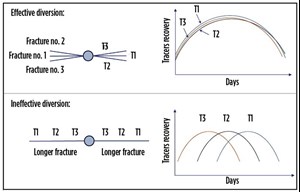
Three distinctively tagged smart tracers were added before and after each diverter stage to assess the efficiency of the frac diverters in creating multiple fracs to increase the reservoir contact area and flow paths. However, surface pressure readings, taken after the diverters were injected, suggested diversion may not be occurring, in that incremental surface pressure was roughly 400 psi, whereas effective diverter placement would propagate new fractures with a resulting pressure increase of 800 to 1,200 psi.
To validate the evidence of inefficient diversion, flowback samples were taken and tested onsite for 10 consecutive days to measure the subsequent recovery rate of the smart tracers. Ideally, if the diverters were functioning as designed, near uniform recovery rates would be observed for all the tracers. However, one set of the tagged smart tracers came back in a comparably larger quantity, confirming that diversion was not occurring, as recoveries were coming only from one large frac, rather than the multiple flow paths intended. Validation of the pressure reading reinforced the value of the smart tracers in assessing diverter efficiency, or in this case, inefficiency, Fig. 4. Given the resulting data, Petralis netted savings of around $100,000/well that otherwise would have been spent on what was determined to be an ineffectual diversion strategy.
Afterwards, Petralis requested sampling and analysis on four offsets to gain a better understanding of the reservoir, insofar as inter-well communication was concerned. The resulting data provided valuable spacing, communication and reservoir insights, as the company planned to drill additional development wells on the asset.
Hydraulic fracturing of a vertical well is unique, in that the induced fractures are inherently planar, as they are not subjected to the tortuous path of an unconventional well, but rather follow a so-called preferred fracture plane (PFP). With this distinction in mind, samples were taken from four offset wells to determine surface recovery rates and potential communication.
The results showed two of the offsets achieving detectable tracer recovery rates on surface, while the remaining two wells had zero recovery. A consequent geological examination of faults and the preferred orientation of the frac revealed the induced fracture was propagating in the direction of the two wells with full tracer recovery. These data enabled Petralis to map the entire Tennessee Colony asset to optimize spacing and avoid inter-well communication of future development wells to help ensure maximum production.
As the Tennessee Colony field development project illustrates, the capacity of the smart tracers to enhance well performance and ESG metrics, and reduce costs, represents a step change advancement in the industry’s universal transition to the completions of the future.
REFERENCES
- Shokanov, Talgat, and Pavel Khudorozhkov, QuantumPro Inc., and Adilkhan Shokanov, Abai University, “Unleashing the power of smart particles for completion diagnostics: Advancing the production flow profiling technology with sub-atomic fingerprints and big data analytics,” SPE paper 196172-MS, presented at the 2019 SPE Annual Technical Conference and Exhibition, Calgary, Alberta, Canada., Sept. 30-Oct. 2, 2019.
- Opeoluwa, Olawale, University of Ibadan, “Nanocompletions versus intelligent well completions, investigating the future of nanotechnology in well completions - A case study,” SPE paper 172380-MS, presented at the SPE Nigeria Annual International Conference and Exhibition, Lagos, Nigeria, Aug. 5-7, 2014.
- Gornick, Stephen, Yusra Khan Ahmad and John Southwell, Nissan Chemical America Corp., “Engineered nanoparticles mitigate frac hits: Reaching more in-place hydrocarbons increases production,” World Oil, January 2020.


- Digital transformation/Late-life optimization: Harnessing data-driven strategies for late-life optimization (March 2024)
- The reserves replacement dilemma: Can intelligent digital technologies fill the supply gap? (March 2024)
- Digital tool kit enhances real-time decision-making to improve drilling efficiency and performance (February 2024)
- U.S. oil and natural gas production hits record highs (February 2024)
- Digital transformation: Digital twins help to make the invisible, visible in Indonesia’s energy industry (January 2024)
- Digital transformation: A breakthrough year for digitalization in the offshore sector (January 2024)
- Applying ultra-deep LWD resistivity technology successfully in a SAGD operation (May 2019)
- Adoption of wireless intelligent completions advances (May 2019)
- Majors double down as takeaway crunch eases (April 2019)
- What’s new in well logging and formation evaluation (April 2019)
- Qualification of a 20,000-psi subsea BOP: A collaborative approach (February 2019)
- ConocoPhillips’ Greg Leveille sees rapid trajectory of technical advancement continuing (February 2019)

